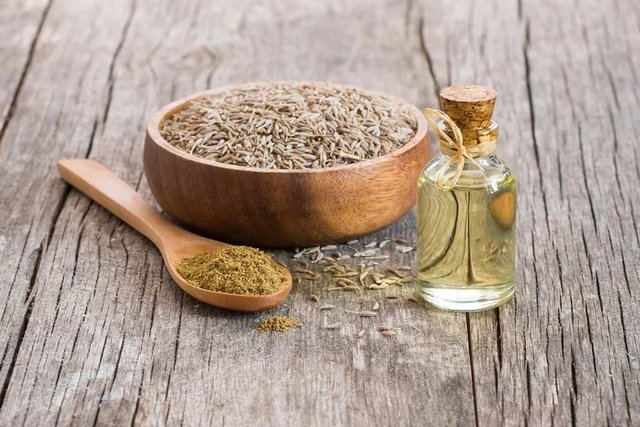Cumin is a spice that is used in cooking to flavor and aromatize food. In addition, it also serves as a home remedy to improve digestive disorders, such as excess gas and indigestion, as well as lower blood sugar and blood pressure.
These benefits are due to the fact that cumin has several bioactive compounds, such as cuminaldehyde, cymene and terpenoids, as well as flavonoids and terpenes, which guarantee this spice its antioxidant, anticancer, digestive, immunostimulant, hypoglycemic, antihypertensive, antimicrobial and vasodilatory properties. .
The scientific name of cumin is cumin cumin and can be purchased in powder or seed form in supermarkets, health food stores, online stores and in some open-air markets. This spice is characterized by having a warm flavor and aroma, enhancing the natural sweetness of food, being easily identified when added to food.

What is it for
Cumin brings several health benefits, serving to:
1. Improve digestion
Cumin helps improve digestion because it stimulates the action of digestive enzymes in the pancreas, which are responsible for digesting food in the intestine. Furthermore, it also increases the excretion of bile, facilitating the absorption of fats in the intestine.
All of these properties reduce the time it takes to digest food, making the digestive process more efficient and reducing the production of intestinal gases.
2. Improve diabetes
Cumin has hypoglycemic properties, as it is rich in phenolic compounds and flavonoids, which can help reduce blood sugar, making it an excellent option for preventing or improving diabetes.
3. Help regulate blood pressure
Cumin has anti-inflammatory, antioxidant and vasodilatory properties that help reduce blood pressure. This benefit is believed to be possible due to the fact that cumin is capable of promoting the production of nitric oxide, a gas that helps keep blood vessels relaxed, in addition to reducing oxidative stress and inflammation.
In addition, it has a large amount of potassium, a mineral that favors the excretion of sodium through urine, also helping to reduce blood pressure.
4. Strengthen the immune system
Cumin is rich in B vitamins, iron and zinc, as well as containing vitamins C, A and E, all of which are essential nutrients for increasing the body’s defenses and improving the immune system.
5. Improve blood circulation
Cumin helps relax blood vessels, helping to regulate blood pressure and improve blood circulation. In addition, it has vitamin K, a micronutrient that helps prevent blood clotting.
6. Prevent cancer
Regular consumption of cumin can help reduce the risk of stomach, colon and liver cancer, as it has antioxidant properties that help protect the body’s cells from damage caused by free radicals.
7. Help fight anemia
Cumin is rich in iron, an essential mineral for maintaining the production of hemoglobin, a protein responsible for transporting oxygen from the lungs to the rest of the heart, helping to prevent or improve anemia.
8. Take care of the health of your bones and teeth
Cumin is rich in calcium and phosphorus, minerals that are essential for the care of bones and teeth, preventing the emergence of diseases such as osteoporosis and osteopenia.
Furthermore, it could reduce the risk of having cavities, as it has an antimicrobial action against the Streptococcus mutansa bacteria that can be naturally found in the mouth and that when it proliferates can cause cavities.
Furthermore, it contains phytoestrogens that reduce the loss of calcium through urine, promoting bone health.
9. Have antimicrobial action
Cumin has antimicrobial action and some studies indicate that the seed oil is capable of inhibiting the growth of bacteria Klebsiella pneumoniae, Streptococcus mutans e Streptococcus pyogenes. Furthermore, it has antifungal action against fungi and yeasts.
10. Help lower cholesterol
Due to its antioxidant action and amount of saponins, which are organic compounds that can be found in various plants, cumin can help reduce LDL cholesterol by preventing its absorption in the intestine.
Nutritional information
The following table provides nutritional information for every 100 grams of cumin powder and for each teaspoon (5 grams):
It is important to remember that the health benefits of cumin are obtained when consumed in the context of a healthy diet, that is, when you practice physical activity regularly and have a healthy and balanced diet.
How to use cumin
Cumin powder can be used as a seasoning for soups, broths, meats and dishes with chicken and grains, such as beans and lentils, for example.
cumin tea
Cumin leaves and seeds can be used to prepare tea.
Ingredients
- 1 tablespoon of cumin leaves or 1 teaspoon of cumin seeds;
- 200 mL of boiling water.
Preparation mode
Place the leaves or seeds in boiled water, cover and let it rest for about 10 minutes. Then strain and drink 2 to 3 cups of tea per day.
Possible side effects
Some of the possible side effects of consuming cumin are allergic reactions, which may include redness, inflammation, peeling and itching of the skin. In case of severe allergies, there may also be difficulty breathing, swelling in the mouth, eyes and nose.
Furthermore, it can cause hypoglycemia, especially if consumed in excess and together with oral antidiabetics, in addition to increasing the risk of bleeding due to its vitamin K content.
Who should not consume cumin
Cumin should be consumed with caution by pregnant and lactating women, especially in its essential oil form.
Furthermore, people who use oral antidiabetics, antibiotics, antifungals and anticonvulsants should consult their doctor before consuming cumin. It is also recommended to avoid consumption 2 weeks before surgical procedures due to the vitamin K content, which could increase the risk of bleeding.
Healthy recipes with cumin
1. Beans with cumin
Ingredients:
- 2 cups of carioca beans, already soaked
- 6 cups of water
- 1 chopped onion
- 2 garlic cloves
- 2 tablespoons of olive oil
- 2 bay leaves
- 1 teaspoon cumin powder
- salt and freshly ground black pepper to taste
Preparation mode:
Place the soaked beans in the pressure cooker, add 6 cups of water and bay leaves, leaving them in the pan after coming to pressure for 10 minutes.
After cooking the beans, heat the oil in a pan to sauté the onion until it starts to lighten, then add the garlic and cumin. Add 2 ladles of cooked beans, mix well and knead with a spoon to help thicken the remaining bean broth.
Add this mixture with the rest of the beans and sauté everything over low heat for another 5 minutes.
2. Cumin Chicken
Ingredients:
- 4 chicken fillets cut into cubes
- 3 cloves of garlic, chopped
- 2 medium onions chopped
- 2 tablespoons chopped coriander
- 1 teaspoon of cumin powder
- 2 bay leaves
- juice of 2 lemons
- 4 tablespoons of olive oil
Preparation mode:
Stir all the ingredients together and mix in the chicken breast cubes and leave to marinate for at least 2 hours in the refrigerator. Then, grease a frying pan with olive oil and add the chicken, gradually watering it with the marinade sauce.

Sign up for our newsletter and stay up to date with exclusive news
that can transform your routine!
Warning: Undefined array key "title" in /home/storelat/public_html/wp-content/plugins/link-whisper-premium/templates/frontend/related-posts.php on line 12
Warning: Undefined array key "title_tag" in /home/storelat/public_html/wp-content/plugins/link-whisper-premium/templates/frontend/related-posts.php on line 13



